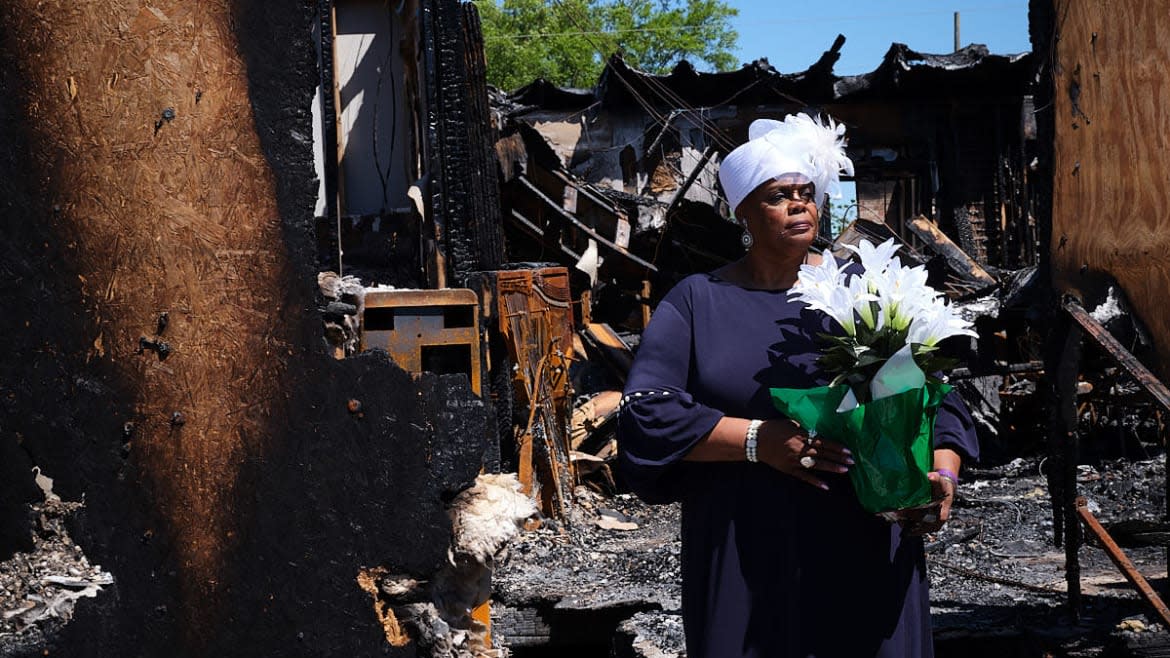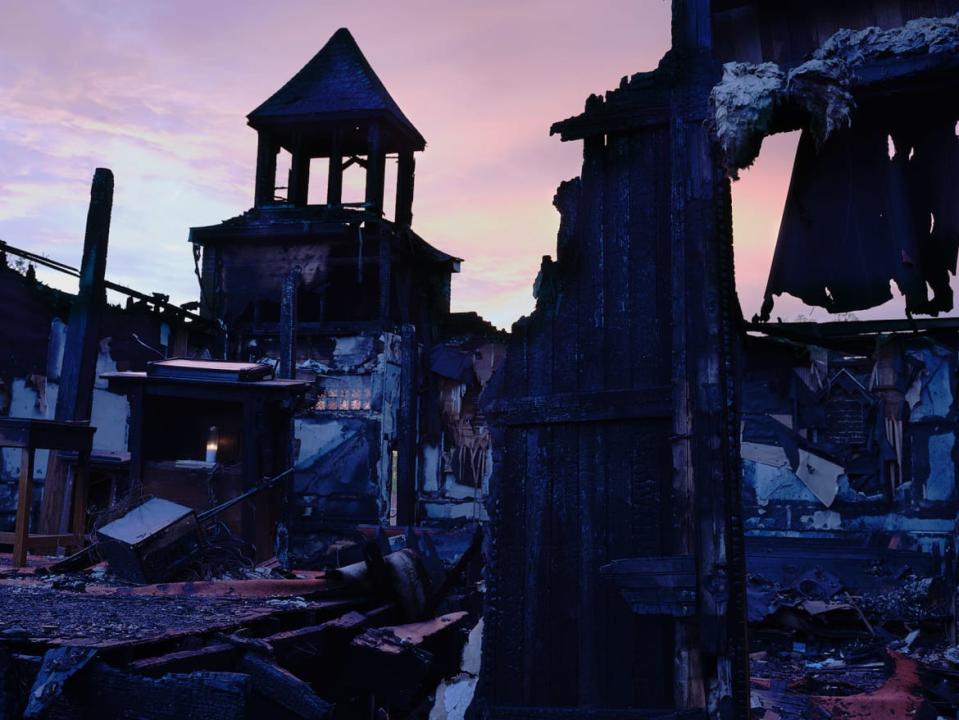Black Parishioners in Louisiana Pray on Easter for Alleged Racist Who Burned Down Their Church

OPELOUSAS, Louisiana—Decked out in vibrant pink and yellow dresses and suits and elaborate hats, the all-black congregation of the Greater Union Baptist Church packed into a plain, windowless room in a private Masonic lodge with plastic folding chairs Sunday morning to hold their Easter service.
They’ve been gathering in this cramped donated space since April 2, when their historic church was burned to the ground in a series of alleged suspected hate crimes that destroyed three black churches over nine days.
Spirits were high, despite the circumstances. The gospel choir sang, and the churchgoers danced and hollered and praised exuberantly, as if nothing were different. Occasionally, bits of grief broke through: A woman burst into tears and started sobbing into her lap, and people passed a box of tissues down the row and rubbed her back until she recovered. Otherwise, the mood felt something like triumph.

The remains of Greater Union Baptist Church in St. Landry’s Parish, Louisiana, one of three black churches destroyed in a string of arsons that authorities consider a hate crime.
Reverend Harry Richard addressed the fire many times in his sermon. He praised the congregation for handling the tragedy so gracefully amid all the media attention, and for resisting angry reactions. He urged continued empathy and prayers for the suspect in police custody, a 21-year-old white man named Holden Matthews, and his family.
“Holden and his parents, I think about what they must have been going through,” he said. “I would hate for that to have been my son. How would I feel? I put myself in his place. How would I feel if it was my son? Can you imagine that mother and that father waking up that morning and realizing it was their son that did this? Can you feel the heartbreak?”
“Don't ever give up on love,” he continued. “I don't care what the world might do to you. You never give up on love.”
The loss of this church, more than 100 years old, felt like the death of a close family member to many of the people who grew up in it. Monica Guidry Harris, 56, said her mother and father renewed their vows inside those walls every single year for 73 years in a row until they both passed away in the fall, two months apart. They’re buried together in a grave behind the now-burned church. The night of the blaze, Harris received a frantic call from one of her 12 siblings at 2:30 in the morning, and she jumped out of bed to drive to the scene.
“The only thing I could see in my mind was my dad with a waterhose, trying to put the fire out,” she said. “He only had a second grade education. He lived, breathed, everything this church. He used to cut the grass here.”
Several of the Guidry siblings wore matching pins Sunday morning with a picture of their parents on it. “I’m glad Mama and Daddy weren’t here to see the church burn,” said Celina Guidry Richard, 69.
The congregation is hesitant to talk about race or racism with regard to the fire, despite the long, painful history of white supremacists burning black churches in the Deep South. St. Landry Parish, the heart of Cajun country in Louisiana, is 41 percent black and 56 percent white. I grew up here, about five miles from Greater Union. The parish is still fairly segregated — there are black neighborhoods and white neighborhoods, black schools and white schools — but the races have interacted peacefully here for decades. Any tension or strife, like most things in the bayou, swims stealthily beneath the surface.
The older members of the church are keen to keep it that way by treating Matthews’ crime as if it were just an unfortunate anomaly, despite the mounting evidence that he was motivated by racism.
“He could have very well been a black man or a Mexican, it didn't matter to me to that he was white,” said Harris. “He’s 21 years old, what does he know about life? He just ruined the rest of his life. We just started praying for him, that God takes pity on him and opens up his heart, and that way he'll have somewhere to go in his afterlife.”
“It was almost a relief for the black community that it wasn't a black kid,” said Florence Guidry, another of the seven sisters. “We were scared, because we didn't know if it was one ours, one of our grandkids.”
I asked James Vaughn, 75, if the incident brought back memories of similar hate crimes from the civil rights era. “No, it didn’t come back to me,” he said. “The poor child was sick, that's the way I look at it. All you can do is pray for him.”
Some of the younger church members, who didn’t grow up watching black churches burn, are having a much harder time coping with the incident. Brandon Prince, 26, was the only person who answered affirmatively when I asked if he was angry.
“A little,” he said, holding back tears. “I can’t say that I’m not. But it’s like the pastor said: The church isn’t the building. The church is us.”
After their Easter service, at the pile of ash and rubble where the old church used to be, Prince’s mother held him as he sobbed into her chest. Other members carefully walked through the charred debris, picking out half-burned Bible pages and mementos to take home and preserve.
They’ll rebuild the church soon, bigger and better: A GoFundMe page for the three churches has raised over $2 million in the past week, thanks to promotion from celebrities and journalists. The three churches will split the money evenly for rebuilding efforts. Richard, who serves as the secretary for Greater Union, says the whole incident may leave them in a better place than they were before.
“Maybe in some weird way or a blessed way, God had a hand,” she said. “I feel sorry for Holden. He thought destroying a building would destroy our faith and ambition to be better, and he didn’t. All he did was motivate us.”
—Photographs by Glenna Gordon with the Aftermath Project.

